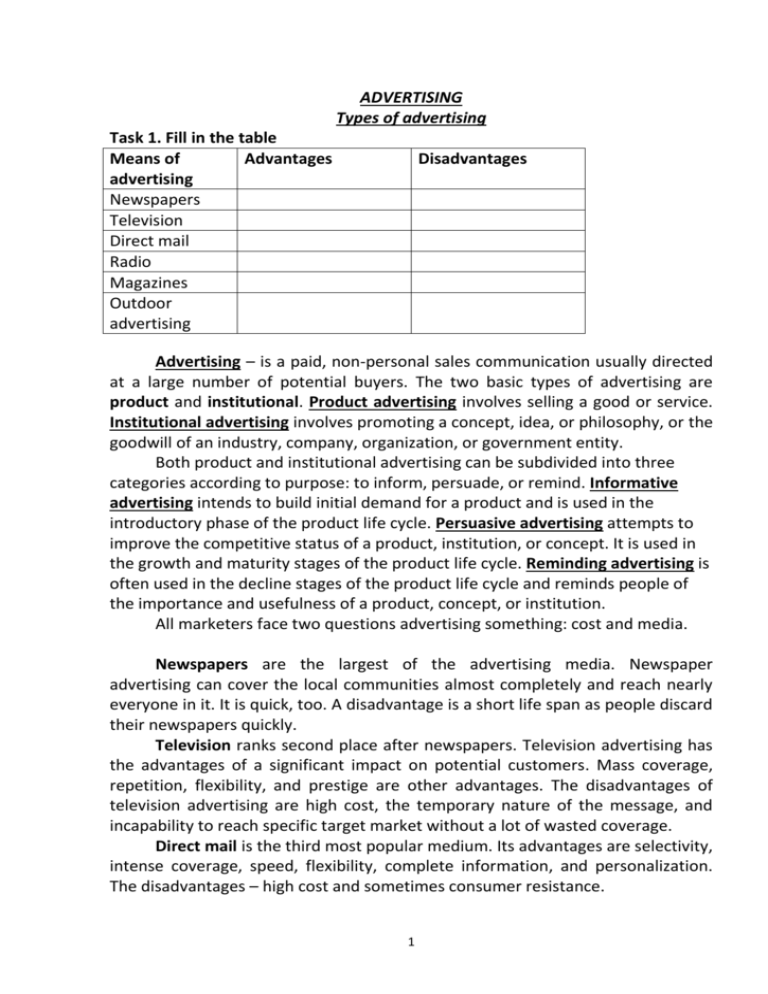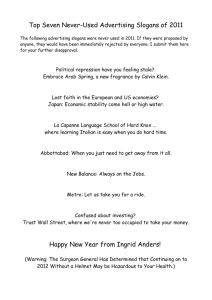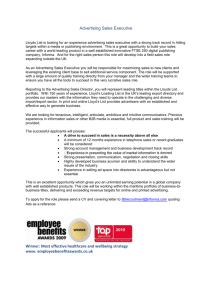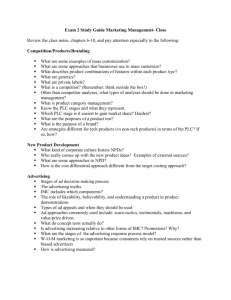ADVERTISING Types of advertising Task 1. Fill in the table Means of
advertisement

ADVERTISING Types of advertising Task 1. Fill in the table Means of Advantages advertising Newspapers Television Direct mail Radio Magazines Outdoor advertising Disadvantages Advertising – is a paid, non-personal sales communication usually directed at a large number of potential buyers. The two basic types of advertising are product and institutional. Product advertising involves selling a good or service. Institutional advertising involves promoting a concept, idea, or philosophy, or the goodwill of an industry, company, organization, or government entity. Both product and institutional advertising can be subdivided into three categories according to purpose: to inform, persuade, or remind. Informative advertising intends to build initial demand for a product and is used in the introductory phase of the product life cycle. Persuasive advertising attempts to improve the competitive status of a product, institution, or concept. It is used in the growth and maturity stages of the product life cycle. Reminding advertising is often used in the decline stages of the product life cycle and reminds people of the importance and usefulness of a product, concept, or institution. All marketers face two questions advertising something: cost and media. Newspapers are the largest of the advertising media. Newspaper advertising can cover the local communities almost completely and reach nearly everyone in it. It is quick, too. A disadvantage is a short life span as people discard their newspapers quickly. Television ranks second place after newspapers. Television advertising has the advantages of a significant impact on potential customers. Mass coverage, repetition, flexibility, and prestige are other advantages. The disadvantages of television advertising are high cost, the temporary nature of the message, and incapability to reach specific target market without a lot of wasted coverage. Direct mail is the third most popular medium. Its advantages are selectivity, intense coverage, speed, flexibility, complete information, and personalization. The disadvantages – high cost and sometimes consumer resistance. 1 Radio – has the advantage of the immediacy, low cost, target audience selection, flexibility, and mobility. Disadvantage is the short life span of a radio message. Magazines has the advantages of selectivity, quality reproduction, long life, and prestige. But there is no flexibility of newspapers and radio. Outdoor advertising, such as billboards, communicate simple ideas quickly. Other advantages are repetition and the ability to promote goods and services available for sale nearby. The disadvantage is messages must be brief. There are a lot of other options that companies can use to advertise products. Other media are advertising in movie theatres and on airline movie screens, on trucks, buses, trolley-buses and trams. Vocabulary product advertising – реклама продукції institutional advertising – промислова реклама (закладу, організації) promotion – пропагандистська діяльність informative advertising – інформативна реклама to persuade – переконувати to remind – нагадувати growth and maturity stages –стадії зростання та зрілості product life cycle – життєвий цикл продукту decline stage – стадія спаду mass media – засоби масової інформації initial demand – початковий попит advantages and disadvantages – переваги та недоліки flexibility – гнучкість immediacy – невідкладність a short life span – невеликий відрізок життя spot advertising – вибіркова реклама billboard advertising – реклама на стендах Task 2. Answer the following questions: 1. 2. 3. 4. What is the purpose of advertising? What specialized firms dealing with advertising do you know? How may the goods be advertised? What are the differences among informative, persuasive, comparative, and reminding advertising? 5. Which is the most popular advertising media? 6. What does the choice of media for advertising depend on? 7. What are the advantages and disadvantages of advertising media? 2 Task 3. Slogans. Read the text about translations of slogans and brand names, and note the problem in each case. Many advertisements contain a slogan or short phrase to attract the consumer’s attention. Effective slogans are usually short, easy to remember, easy to repeat and easy to translate for international markets but not always… In Taiwan, the translation of the Pepsi slogan “Come alive with the Pepsi generation” came out as “Pepsi will bring your ancestors back from the dead”. When Parker marketed a pen in Mexico, its ads were supposed to say “It won’t leak in your pocket and embarrass you.” however, the company translated “embarrass” as “embarazar”, which means “to become pregnant”. So the ads said “It won’t leak in your pocket and make your pregnant”. In Italy, a campaign for Schweppes Tonic Water translated the name as Schweppes Toilet Water. Colgate introduced a toothpaste in France called Cue, the name of a French pornographic magazine. Task 4. Designing a Television Commercial A TV commercial generally consists of a short film sequence of between 30 and 60 seconds with an accompanying sound track which includes a mixture of live recordings (what people actually say in the commercial), a voice-over (the voice of someone who does not appear on screen) and music and sound effects. Various techniques are used in commercials to convince the viewer of the value of the product or service that is being advertised. One of the most common of these is “dramatization” where a short story is developed around the product or service. The original ideas behind a commercial of these types are developed from a scenario, a written document that summarises the action, the atmosphere, the characters and the scene where the sequences of the commercial will be filmed. An artist then produces a storyboard, or series of pictures, to show how the commercial will look. Promoting a product involves developing a “Unique Selling Proposition” (“USP”): features and benefits which make it unlike any of the competing products. There are four stages in promoting a product (“AIDA”) : 1. Attract the ATTENTION of potential customers; 2. Arouse INTEREST in the product; 3. Create a DESIRE for its benefits; 4. Encourage customers to take prompt ACTION. 3 Task 5. Read, translate and act out the dialogue. - Can I see the Advertising Manager today? This is Mr Klimenko speaking. - Unfortunately Ms Abbot is off. She is having her lunch with the designer. Will you leave a message for her? - Yes, please. I would like to invite her to dinner and to listen to her ideas as how to train our advertising agents. What time will she be back from lunch?, - At 2.30 I suppose. - So what time may I call again? - After 5. From 5 to 6. - She is a difficult person to get hold of, isn’t she? - Yes, sir, but it’s her work. …Oh, you are lucky today. Here is an Agency’s Executive, Andrew. He is waiting for Ms Abbot too and could tell you about his work, if you are interested. - Nice to meet you, Andrew. Your position is something new for me. So I’d like to know more about it. - As the agency has contacts with the advertiser I need the aptitudes of both a salesman and a manager. I work with the client to determine the advertising objectives and to obtain final approval of a campaign. I also work with the agency’s personnel to develop advertising messages, media, and find facts to implement these objectives. - I see. I find your position absolutely necessary for the agency. - Certainly. And for more information you should come to our agency. I could arrange an appointment for you with the Manager. Task 6. Read the advertising of a car, form the questions to it, and make up your own one. Alpha Romeo 1991 Blue, One owner. Excellent condition. 20,000 miles. No accidents. $ 2800 Task 7. Fill in the gaps with the derivatives of the word advertise and produce. a) b) c) d) e) f) We can’t publish this material since our _____ don’t like it. Put an____ in the paper concerning your job. I prefer working for different ____ agencies. During his work at the plant he became a very____ manager. Since we bought the computer, ____ has increased by 15%. Henry Ford began the mass ____ of automobiles. 4







